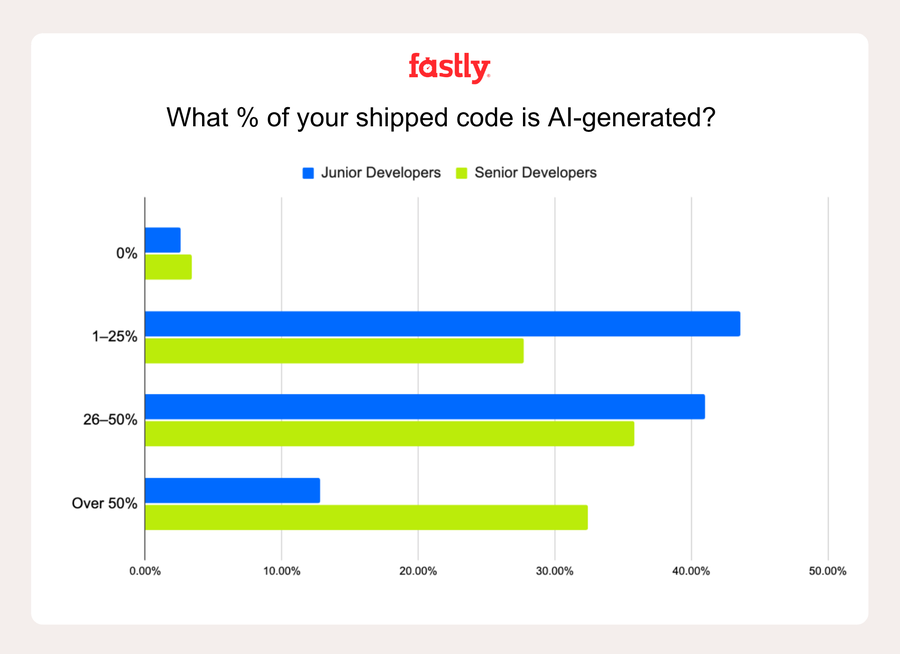Vibe Shift? Senior Developers Ship nearly 2.5x more AI Code than Junior Counterparts

Content Marketing Manager

Fastly’s July 2025 survey of 791 developers found a notable difference in how much AI-generated code is making it into production. About a third of senior developers (10+ years of experience) say over half their shipped code is AI-generated — nearly two and a half times the rate reported by junior developers (0–2 years of experience), at 13%.
“AI will bench test code and find errors much faster than a human, repairing them seamlessly. This has been the case many times,” one senior developer said. A junior respondent noted the trade-offs: “It’s always hard when AI assumes what I’m doing and that’s not the case, so I have to go back and redo it myself.”
Senior developers were also more likely to say they invest time fixing AI-generated code. Just under 30% of seniors reported editing AI output enough to offset most of the time savings, compared to 17% of juniors. Even so, 59% of seniors say AI tools help them ship faster overall, compared to 49% of juniors.

Senior Developers Are More Optimistic About AI Saving Time
Just over 50% of junior developers say AI makes them moderately faster. By contrast, only 39% of more senior developers say the same. But senior devs are more likely to report significant speed gains: 26% say AI makes them a lot faster, double the 13% of junior devs who agree.
One reason for this gap may be that senior developers are simply better equipped to catch and correct AI’s mistakes. They have the experience to recognize when code “looks right” but isn’t. That makes them more confident at using AI tools efficiently, even for high-stakes or business-critical code. By contrast, junior developers may not fully trust their ability to spot errors, which can make them more cautious about relying on AI, or more likely to avoid using it in production at all.
That tracks with how much AI-generated code actually makes it into production. Among junior devs, just 13% say over half of their shipped code is AI-generated. By contrast, 32% of senior developers say the same, suggesting that more experienced engineers are not only using AI more aggressively, but are also trusting it more in production environments. This is surprising given growing concerns about “vibe coding” introducing vulnerabilities into applications.
Perception vs. Reality
Nearly 1 in 3 developers (28%) say they frequently have to fix or edit AI-generated code enough that it offsets most of the time savings. Only 14% say they rarely need to make changes. And yet, over half of developers still feel faster with AI tools like Copilot, Gemini, or Claude.

Fastly’s survey isn’t alone in calling AI productivity gains into question. A recent randomized controlled trial (RCT) of experienced open-source developers found something even more striking: when developers used AI tools, they took 19% longer to complete their tasks.
This disconnect may come down to psychology. AI coding often feels smooth: code autocompletes with a few keystrokes. This gives the impression of momentum, but the early speed gains are often followed by cycles of editing, testing, and reworking that eat into any gains. This pattern is echoed both in conversations we've had with Fastly developers and in many of the comments we received in our survey.
One respondent put it this way: “An AI coding tool like GitHub Copilot greatly helps my workflow by suggesting code snippets and even entire functions. However, it once generated a complex algorithm that seemed correct but contained a subtle bug, leading to several hours of debugging.”
Another noted: “The AI tool saves time by using boilerplate code, but it also needs manual fixes for inefficiencies, which keep productivity in check.”
Yet, AI still seems to improve developer job satisfaction. Nearly 80% of developers say AI tools make coding more enjoyable. For some, it’s about skipping grunt work. For others, it might be the dopamine rush of code on demand.

“It helps me complete a task that I’m stuck with. It allows me to find the answers necessary to finish the task,” one survey respondent says.
Enjoyment doesn’t equal efficiency, but in a profession wrestling with burnout and backlogs, that morale boost might still count for something.
The Hidden Cost of AI Coding
Fastly’s survey also explored developer awareness of green coding—the practice of writing energy-efficient software— and the energy cost behind AI coding tools. The practice of green coding goes up sharply with experience. Just over 56% of junior developers say they actively consider energy use in their work, while nearly 80% among mid- and senior-level engineers consider this when coding.
Developers are very aware of the environmental cost of AI tools: roughly two-thirds of developers across all experience levels said they know that these tools can carry a significant carbon footprint. Only a small minority (under 8% even at the most junior levels) were completely unaware. Altogether, the data suggests that sustainability is increasingly embedded in developer culture.
Methodology
This survey was conducted by Fastly from July 10 to July 14, 2025, with 791 professional developers. All respondents confirm that writing or reviewing code is a core part of their job. The survey is distributed in the US and quality-controlled for accuracy, though, as with all self-reported data, some bias is possible.